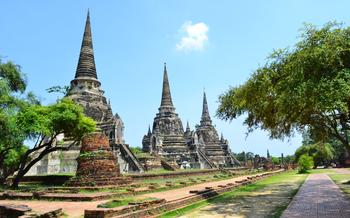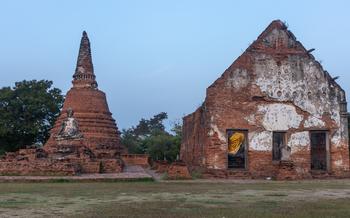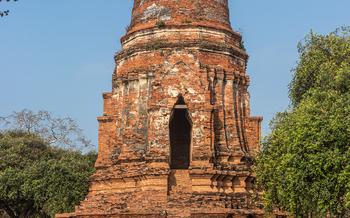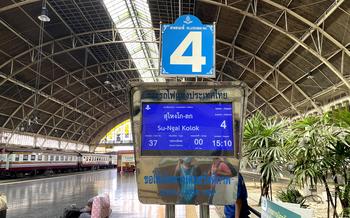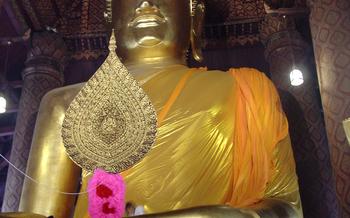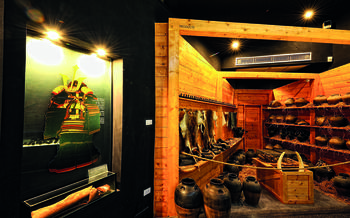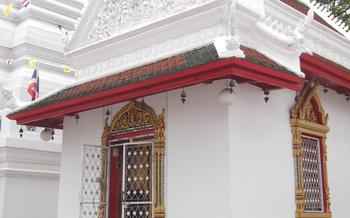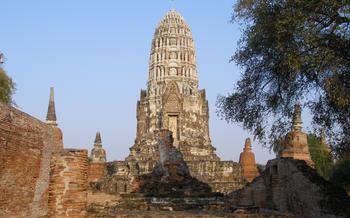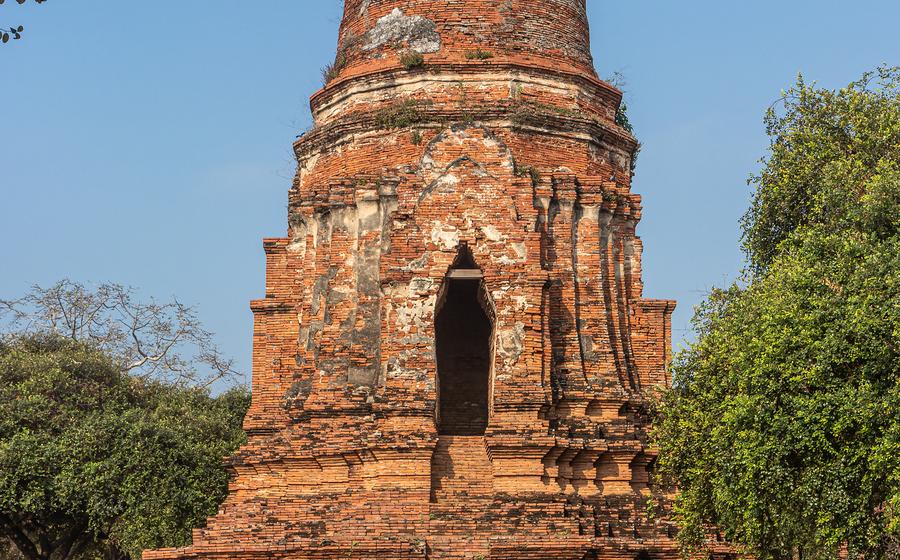
Wat Tha Sai
- Historical Significance
- Stunning Architecture
- Serene Atmosphere
- Impressive Buddha Statues
- Royal Connections
- Local Traditions and Festivals
- Photography Opportunities
- Guided Tours
- Nearby Attractions
- Food and Drinks
- Getting There
- Temple Hours and Admission
- Accommodation Options
- Insider Tip
Historical Significance
Wat Tha Sai holds a significant place in Thai history, having served as a royal temple since its establishment in the 14th century. It was closely associated with the Ayutthaya Kingdom, and its architecture and artifacts reflect the grandeur and opulence of the era. The temple's central prang, or main tower, is a testament to the architectural prowess of the Ayutthaya period, while the intricate carvings and decorations that adorn its walls and pillars showcase the exquisite craftsmanship of the time.
The temple is home to a collection of Buddha statues and religious artifacts that hold immense cultural and religious significance. The most revered of these is the Phra Buddha Sai, a large bronze Buddha image that serves as the temple's primary object of worship. Believed to date back to the 14th century, the statue exudes an aura of serenity and compassion, attracting pilgrims and devotees from all over the country.
Stunning Architecture
Wat Tha Sai is renowned for its captivating architectural design that harmoniously blends elements from different eras. The temple complex features a striking prang, a towering spire that symbolizes Mount Meru, the abode of the gods in Buddhist cosmology. The ordination hall, or wihan, is another architectural masterpiece, showcasing intricate carvings and elaborate murals depicting scenes from the Buddha's life and teachings.
The exterior of the temple is adorned with an array of intricate carvings, bas-reliefs, and sculptures that tell stories from Buddhist mythology and history. These intricate embellishments add depth and texture to the temple's facade, creating a captivating visual experience.
Inside the ordination hall, visitors are greeted by a serene and awe-inspiring atmosphere. The walls are adorned with vibrant murals that depict scenes from the Buddha's life and teachings, offering a glimpse into the rich history and philosophy of Buddhism. The intricate details and vibrant colors of these murals captivate visitors, transporting them to a realm of spiritual contemplation.
Preserving and maintaining this architectural heritage is of utmost importance to ensure that future generations can continue to appreciate the beauty and significance of Wat Tha Sai. The temple's unique architectural features, combined with its historical and religious importance, make it a must-see destination for anyone interested in Thai culture and architecture.
Serene Atmosphere
Wat Tha Sai exudes a peaceful and tranquil ambiance that invites visitors to find solace and mindfulness within its sacred grounds. The lush greenery surrounding the temple creates a serene environment, where visitors can escape the hustle and bustle of city life and connect with their inner selves. The temple's tranquil atmosphere is conducive to meditation and reflection, making it a popular destination for those seeking a spiritual retreat.
The temple's serene atmosphere is particularly noticeable during the early morning hours, when the air is fresh and cool, and the grounds are bathed in a soft golden light. It is also a serene experience to visit the temple in the late afternoon, as the sun begins to set and the temple casts long shadows across the grounds.
The temple's peaceful ambiance is not only due to its natural surroundings but also to the respectful and mindful behavior of the visitors. Visitors are encouraged to be quiet and respectful, creating a harmonious atmosphere that allows everyone to fully appreciate the temple's sacredness and tranquility.
Impressive Buddha Statues
Wat Tha Sai is home to a collection of impressive Buddha statues that are sure to captivate visitors. The most notable statue is the large bronze Buddha image known as the Phra Buddha Sawan, which stands tall in the main ordination hall. This revered statue is adorned with intricate carvings and exudes an aura of serenity and tranquility.
Other notable Buddha images include a large reclining Buddha statue, as well as a number of smaller Buddha statues in various poses and styles. Each statue has its own unique symbolism and significance, representing different aspects of the Buddha's teachings and life.
Visitors are encouraged to take their time to admire the Buddha statues and contemplate their spiritual significance. It is important to show respect and reverence when visiting the temple and its sacred objects. Remember to remove your shoes before entering the temple and avoid touching or climbing on the Buddha statues.
Royal Connections
Wat Tha Sai is deeply intertwined with the history and traditions of the Thai royal family. The temple holds a revered position as a royal temple, having been closely associated with the monarchy for centuries. Over the years, the temple has played a pivotal role in numerous royal ceremonies and events, serving as a sacred venue for coronations, royal weddings, and other significant occasions. The Thai royal family has shown unwavering patronage and support for Wat Tha Sai, contributing to its grand construction and exquisite ornamentation. Interestingly, the temple is home to a highly revered Buddha statue known as Phra Buddha Lokanat, which is believed to have been cast under the patronage of King Naresuan the Great, a legendary Thai monarch. This statue is deeply revered by the locals and is considered a precious symbol of the temple's royal connections.
Local Traditions and Festivals
Wat Tha Sai is deeply intertwined with the local community and serves as a vibrant hub for traditional celebrations and festivals. Throughout the year, the temple hosts a variety of events that showcase the rich cultural heritage of Ayutthaya.
One of the most significant festivals is the annual temple fair, known as the "Bun Bang Fai" or "Rocket Festival." This lively event takes place in May and features a colorful procession of elaborately decorated rockets, traditional music and dance performances, and a lively market filled with local delicacies and handicrafts. Visitors can witness the launch of these rockets, which are believed to bring good luck and prosperity to the community.
Other festivals celebrated at Wat Tha Sai include the "Songkran" or Thai New Year festival in April, which involves water splashing and merit-making ceremonies, and the "Kathin" festival in October, which marks the end of the Buddhist Lent and features the offering of new robes to monks. Participating in these festivals is a wonderful way to immerse oneself in the local culture and experience the vibrant traditions of Ayutthaya.
Photography Opportunities
Wat Tha Sai is a photographer's paradise, offering a treasure trove of photogenic spots that capture the essence of this historic and beautiful temple. The intricate carvings and decorations on the temple's exterior provide a feast for the eyes, while the serene atmosphere and lush greenery create a picturesque backdrop for your shots. Don't miss the opportunity to capture the grandeur of the prang, the elegance of the ordination hall, and the serene beauty of the Buddha statues.
For the best lighting conditions, plan your visit during the early morning or late afternoon when the soft, golden light casts a warm glow on the temple's architecture. Experiment with different angles and perspectives to create unique and captivating compositions. Don't forget to capture the details, such as the delicate lotus motifs and intricate carvings that adorn the temple's walls and pillars.
Share your stunning photos on social media using hashtags like #WatThaSai, #Ayutthaya, and #Thailand to inspire other travelers and showcase the beauty of this hidden gem. Remember to tag the temple's official social media accounts to show your appreciation and connect with the local community.
Guided Tours
Exploring Wat Tha Sai with a knowledgeable guide can greatly enhance your experience. Guides can provide insights into the temple's history, architecture, religious significance, and local traditions. They can point out hidden details and explain the symbolism behind various elements, allowing you to gain a deeper understanding of this sacred site.
Booking a guided tour in advance is recommended to secure your spot and avoid disappointment. Many local tour operators offer guided tours of Wat Tha Sai, and you can find reputable guides through online platforms or by asking your hotel or guesthouse for recommendations.
Guided tours typically last for an hour or two, providing ample time to explore the temple's main highlights. Prices vary depending on the size of the group and the duration of the tour. Make sure to inquire about the cost and any additional fees before booking your tour.
By taking a guided tour of Wat Tha Sai, you'll gain valuable insights and a deeper appreciation for this magnificent temple. It's an investment that will enrich your visit and leave you with lasting memories.
Nearby Attractions
In addition to its historical and spiritual significance, Wat Tha Sai is conveniently located near several other attractions that visitors can explore. Just a short walk away is the Ayutthaya Historical Park, a UNESCO World Heritage Site that features the ruins of ancient temples and palaces. Visitors can wander among the remnants of this once-thriving city and learn about its rich history.
For those interested in art and culture, the Ayutthaya National Museum is a must-visit. This museum houses a collection of artifacts and relics from the Ayutthaya period, providing a glimpse into the kingdom's artistic and cultural achievements.
If you're looking for a more active experience, the Chao Phraya River, which flows past Ayutthaya, offers a variety of boat tours and cruises. Visitors can take a leisurely boat ride along the river and admire the beautiful scenery, including the many temples and palaces that line the banks.
To make the most of your visit, consider creating an itinerary that includes multiple attractions. For example, you could start your day by exploring Wat Tha Sai, then visit the Ayutthaya Historical Park and the Ayutthaya National Museum. In the afternoon, take a boat tour along the Chao Phraya River and enjoy the sunset over the ancient city.
A map or directions to help visitors plan their route can be found at the temple's information center or online.
Food and Drinks
When visiting Wat Tha Sai, you'll have a variety of food and drink options to choose from. The temple is surrounded by a number of restaurants and food stalls that offer a variety of Thai and international cuisine. For a truly authentic experience, try the local street food. Here you can find delicious dishes such as pad thai, khao soi, and som tam, all at affordable prices.
If you're looking for a more upscale dining experience, there are several restaurants in the area that offer a more refined menu. These restaurants typically serve Thai and international cuisine, and many of them have outdoor seating areas where you can enjoy your meal while taking in the beautiful surroundings.
No matter what your budget or preferences, you're sure to find something to satisfy your hunger near Wat Tha Sai. Be sure to sample the local street food for a truly authentic Thai experience.
Getting There
Reaching Wat Tha Sai from Bangkok is a convenient and straightforward journey. You can choose from various transportation options to suit your preferences and budget.
Public Transportation:
- Bus:
- Take a public bus from Bangkok's Southern Bus Terminal (Sai Tai Mai).
- Buses depart regularly and take approximately 2 hours to reach Ayutthaya.
-
The fare is around 60-80 THB (Thai Baht).
-
Train:
- Take a train from Bangkok's Hua Lamphong Railway Station.
- Trains depart frequently and take approximately 1 hour and 30 minutes to reach Ayutthaya.
- The fare ranges from 15 THB for a third-class ticket to 70 THB for a first-class ticket.
Private Transportation:
- Taxi:
- Hire a taxi from Bangkok to Ayutthaya.
- The journey takes about 1 hour and 30 minutes, depending on traffic conditions.
-
The fare typically ranges from 1,000 to 1,500 THB.
-
Car Rental:
- If you prefer the flexibility of self-driving, you can rent a car in Bangkok.
- The drive to Ayutthaya takes approximately 1 hour and 30 minutes.
- Car rental rates start from around 800 THB per day.
Upon arriving in Ayutthaya, you can easily reach Wat Tha Sai by tuk-tuk or local taxi. The temple is located about 3 kilometers from the city center.
Temple Hours and Admission
Wat Tha Sai is open to visitors throughout the week from 8:00 AM to 5:00 PM. It is important to note that these hours may vary during special events or holidays. It is advisable to check the temple's official website or contact the local tourist information center for the most up-to-date information.
Admission to the temple is free of charge for all visitors. However, donations are welcome and help to support the upkeep and preservation of this historic site. Visitors who wish to make a donation can do so at the temple office or through donation boxes located throughout the temple grounds.
To avoid the crowds and enjoy a more serene experience, it is recommended to visit Wat Tha Sai during the early morning or late afternoon. The temple is typically less crowded during these times, providing visitors with the opportunity to fully appreciate the tranquility and beauty of this sacred site.
Accommodation Options
Wat Tha Sai, nestled in the heart of Ayutthaya, offers a range of accommodation options to suit every traveler's needs and budget. From budget-friendly guesthouses to luxurious hotels, there's something for everyone.
For those seeking a comfortable and affordable stay, several guesthouses are located within walking distance of the temple. These guesthouses offer basic amenities such as air conditioning, private bathrooms, and Wi-Fi, ensuring a pleasant and convenient stay.
If you prefer a more upscale experience, several hotels are situated a short distance from Wat Tha Sai. These hotels offer a range of amenities, including swimming pools, fitness centers, and rooftop terraces, providing a luxurious retreat after a day of exploring the temple and its surroundings.
To ensure a hassle-free stay, it's advisable to book your accommodation in advance, especially during peak tourist season. This will guarantee you a place to rest and recharge after your temple visit.
Whether you choose a cozy guesthouse or an opulent hotel, the accommodation options near Wat Tha Sai offer a comfortable and convenient base from which to explore this ancient city and its many treasures.
Insider Tip
For an unforgettable experience, plan your visit to Wat Tha Sai during the annual Loy Krathong festival in November. During this festival, the temple grounds transform into a sea of floating lanterns, creating a magical and enchanting atmosphere. Witness the locals releasing their beautifully decorated krathongs, or floating baskets, into the river, symbolizing the letting go of past misfortunes and making wishes for good luck. It's a truly unique and awe-inspiring sight that should not be missed.
